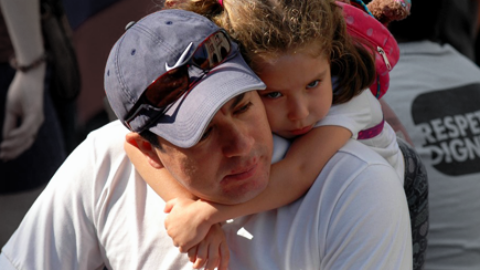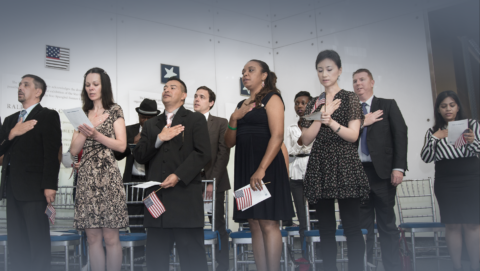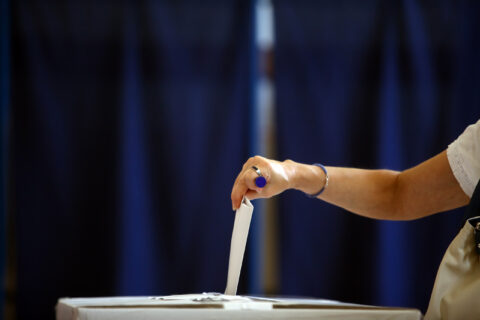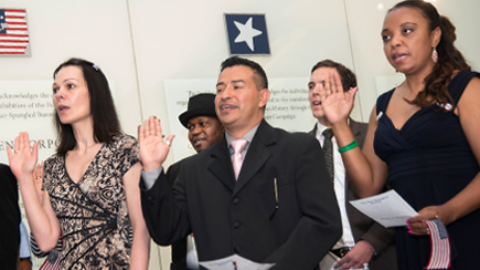Research and Analysis

Unauthorized Immigrants Today
Unauthorized immigrants include adults and children, mothers and fathers, homeowners and people of faith, most of whom are invested in their communities. Read More

How the United States Immigration System Works
U.S. immigration law is very complex, and there is much confusion as to how it works. This fact sheet provides basic information about how the U.S. legal immigration system is designed. Read More

Stepping Up: The Impact of the Newest Immigrant, Asian, and Latino Voters
This analysis of immigration trends and the demographic composition of U.S. House districts shows that numerous congressional districts have emerging electorates who have many reasons to care deeply about immigration reform. Read More

Tackling the Toughest Questions on Immigration Reform
Despite significant public support for immigration reform among members of the public in both parties, many of the most basic facts about immigrants and immigration remain misunderstood. Read More

Crafting a Successful Legalization Program: Lessons From the Past
One of the themes that emerged from the Senate Judiciary Committee mark up of the 2013 Senate immigration bill was the necessity of avoiding the mistakes of the past. In the context of legalization for the 11 million unauthorized immigrants now in the United States, the argument is often made that the 1986 law wasn’t tough enough, and any new legalization program should have more requirements and restrictions. However, in my 39-year career with the Department of Homeland Security (DHS) and former Immigration and Naturalization Service (INS), and after years of studying implementation of the 1986 law, I’ve reached a different conclusion. A successful legalization program depends on simplicity and common sense. There are many lessons to be learned from the 1986 law about how to design a better legalization program. Fortunately, many of those lessons have been absorbed by the drafters of S. 744, the Border Security, Economic Opportunity and Immigration Modernization Act. Nonetheless, as the debate continues on this bill, it is important to reiterate the importance of good design and thoughtful implementation. That is what will ensure success and provide the country with a working immigration system. Read More

Passport Pages Tell Our Tale
Today in the United States, Lesbian, Gay, Bisexual, and Transgender (LGBT) Americans who fall in love with and marry foreign nationals are being asked to choose between country and spouse, country and career, and country and family. I know this because I have spent the last several years in a battle with my own government to recognize my wife for immigration purposes. Trying to keep my marriage to a British national together has cost me my career and a full pension, time away from my American family and friends, as well as a great deal of stress over finances and my future. Gay Americans who are legally married in the U.S. have a marriage that is not recognized by the federal government. Therefore, the 28,500 same-sex binational couples in America, in which one spouse is an American citizen, are in a situation where they cannot sponsor their husbands and wives for immigration purposes. This also means they do not receive the 1,138 federal rights, benefits, protections, and obligations that automatically come with marriage and serve to protect and support families. Read More

Aggravated Felonies: An Overview
This fact sheet provides an overview of “aggravated felonies” under federal immigration law and the immigration consequences of being convicted of an “aggravated felony.” Read More

Legalize Who?: A Portrait of the 11 Million Unauthorized Immigrants in the United States
As the immigration debate heats up in Congress, the central question will be what to do about the 11 million unauthorized immigrants now living and working in the United States. The media often portrays this population as barely literate young men who pour over the southern border and live solitary lives, rather than providing a nuanced understanding of who the 11 million really are: adults and children, mothers and fathers, homeowners and churchgoers who are invested in their communities. This fact sheet attempts to provide a basic understanding of who the unauthorized are as people: where they live, where they’re from, how long they have been here, and what family and community ties to the United States they have. Data from the U.S. Census Bureau and other sources provide this very necessary social context to the immigration debate. And what the data reveal are that most of the unauthorized have been here for over a decade. While they are concentrated in California, Texas, Florida, and New York, there are sizeable unauthorized populations in other states across the country. Three-fifths of unauthorized immigrants come from Mexico, but significant numbers also come from Central America and the Philippines. Nearly half of all adult unauthorized immigrants have children under the age of 18, and roughly 4.5 million native-born U.S.-citizen children have at least one unauthorized immigrant parent. More than half of unauthorized immigrant adults have a high-school diploma or more education. Nearly half of longtime unauthorized households are homeowners. And approximately two-fifths of unauthorized immigrant adults attend religious services every week. In other words, most unauthorized immigrants are already integrating into U.S. society not only through their jobs, but through their families and communities as well. Read More

Back to the Future: The Impact of Legalization Then and Now
While there are many facets to an intelligent immigration reform package, one thing is clear: legalization for undocumented immigrants helps all of us. Most economists recognize that legalization has worked in the past. After a significant percentage of the undocumented population legalized under the Immigration Reform and Control Act of 1986 (IRCA), information on IRCA applicants was used to assess the legislation’s impact. My own research has shown that IRCA provided immediate direct benefits by successfully turning formerly clandestine workers into higher-paid employees. Other researchers have shown that IRCA provided unexpected indirect benefits to the communities where legalized immigrants resided. After legalization, fewer of these immigrants sent money back to their home countries, and those who sent back money sent back less. More of their earnings were spent in their communities in the United States. Research also showed that the legalized population became participating community members—nearly two out of five people who legalized under IRCA were U.S. citizens by 2001. What we learned from IRCA gives us a bird’s eye view into what we can expect to happen with a new legalization program. By examining three areas of concern: work, family, and community, we can see what economic and social benefits would be derived from a legalization program in 2013. By Sherrie A. Kossoudji, Ph.D. Read More

Using the Systematic Alien Verification for Entitlements (SAVE) Program for Voter Eligibility Verification
The evidence of non-citizens voting is sparse and appears subject to much exaggeration. Despite this, many states are asking the federal government for access to immigration data in order to determine whether non-citizens are on the voter registration rolls. For instance, in July 2012, the Director of U.S. Citizenship and Immigration Services (USCIS)—a division of the Department of Homeland Security (DHS)—advised the Florida Secretary of State that states, under limited circumstances, may use the Systematic Alien Verification for Entitlements (SAVE) program for verification of the citizenship status of registered voters. This issue, however, goes beyond Florida. Other states have expressed an interest in using SAVE in a similar fashion. This new development has heightened misconceptions about the SAVE program and its purpose. The Immigration Policy Center’s previously issued fact sheet about the SAVE program focuses on whether SAVE can actually verify whether an individual is in the country lawfully or not. This fact sheet focuses on whether the SAVE program can be used to accurately verify voter eligibility. It explains why SAVE is not a database of all non-citizens, why using SAVE to verify the status of individuals who have registered to vote is a misuse of the program, and how using SAVE for this purpose could lead to denying U.S. citizens the right to vote. What is the SAVE program? Read More
Make a contribution
Make a direct impact on the lives of immigrants.
